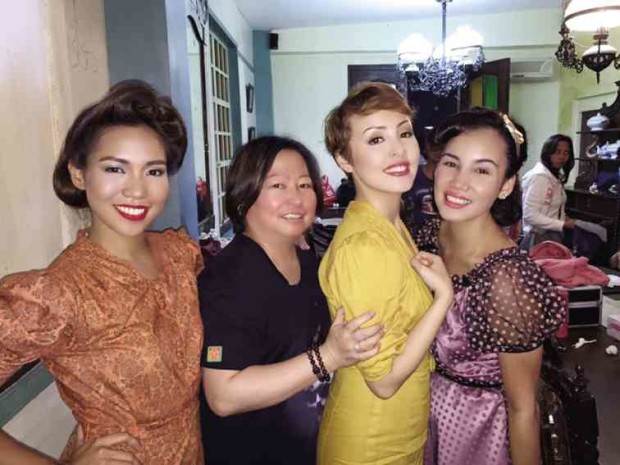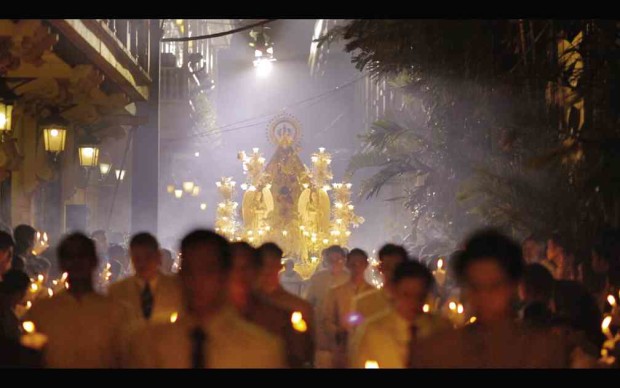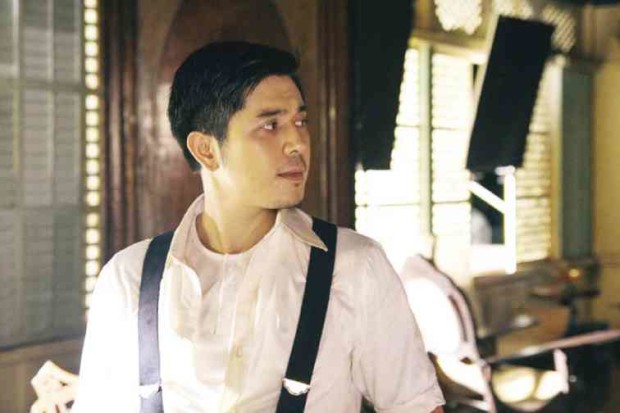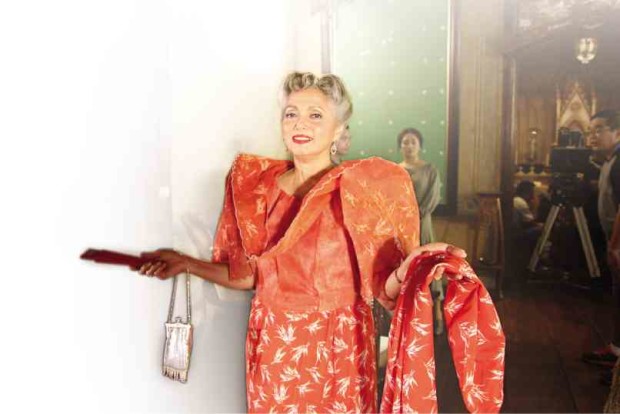‘Larawan’ inspires us to remember, to sing
With grace, sweetness and sadness, sisters Candida and Paula Marasigan will meet a new generation of audiences when National Artist Nick Joaquin’s “Portrait of the Artist as Filipino” is resurrected yet again, this time as a film adaptation of the 1997 stage musical.
Although they hope to attract both the common folk and those who turn up their noses at local movies, producers Celeste Legaspi and Girlie Rodis said they made “Ang Larawan the Musical” into a film primarily to acquaint high school and college students with the well-loved play about family life in prewar Manila.
“We want the kids to have a conversation about why Paula did what she did to the very thing that could have changed their lives,” Rodis said.
Singer Rachel Alejandro plays Paula, the younger Marasigan sister who fell for the charms of a man with sinister designs on their father’s self-portrait. West End (London)-based talent Joanna Ampil is older sister Candida.
The producers said they wanted to focus more on projects with educational value. They also plan to preserve “the great works of our national artists so as to afford the Filipino youth the opportunity to learn about, be challenged by and cherish the country’s history and culture.” They have spun off an earlier production company called Musical Theater Philippines (Musicat) to Culturtain Musicat Productions precisely for such purposes.
Article continues after this advertisementOn the occasion of the 1998 restaging of “Larawan,” Joaquin himself wrote that the musical was an altogether different experience, and thanked the production company, cast and crew “for making it so that we may all live our vocation to remember and to sing.”
Article continues after this advertisementThe film adaptation has been endorsed by the Commission for Higher Education and the National Commission for Culture and the Arts (NCCA).
Although an endorsement from the Department of Education is yet to come, Secretary Armin Luistro acknowledged the relevance of Joaquin’s elegy in three acts “as we continue to struggle for our own identity as a people and a nation.” He said students needed “to see the stark contrast between our prewar and postwar cultures, and the impact of the contrast on how we deal with adversity, how we choose our leaders, how we think and operate as a nation.”
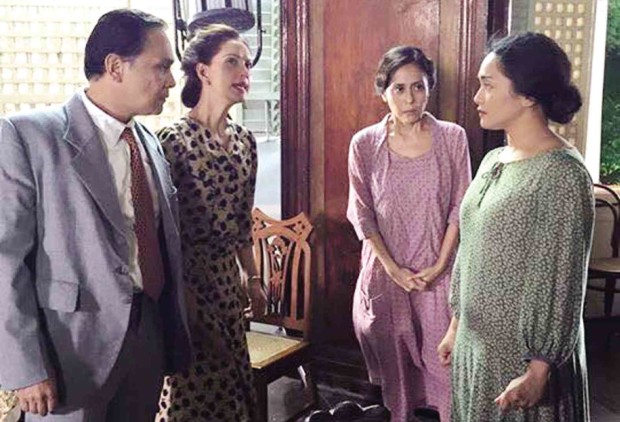
TIES THAT BIND The Marasigan siblings, played by Buencamino, Lauchengco, Alejandro and Ampil, face their problems in this scene from “Ang Larawan” the movie.
Thankfully, the movie version does not contain every song that was in the original musical mounted in 1997 and 1998 at the Cultural Center of the Philippines, or it will be three hours long. Some songs have been shortened and some others have been turned into dialogue. But through all the changes, Legaspi was adamant that Rolando Tinio’s words be preserved.
Joaquin, after all, had agreed to the musical adaptation on condition that Tinio translate his original play and write the
libretto in what he called “Tinio’s Manila Tagalog,” which he acknowledged as “the language for ‘Portrait’” (from the 1998 “Larawan” program). Tinio himself said “adapting ‘Portrait’ into a musical has turned the elegy into a celebration.”
All the dialogues were filmed live, Legaspi said, but all the songs were recorded before filming except one, Candida’s dimly lit and most demanding solo in Act One, which she insisted Ampil sing live during filming.
“It was more difficult to shoot but it really made a difference,” said Legaspi, who herself essayed the Candida role for the stage musical.
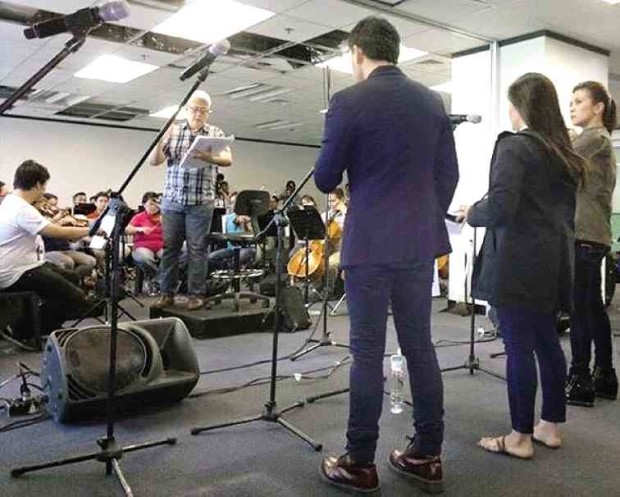
TURNING the elegy into a celebration, Cayabyab and the cast record the music with ABS-CBN Philharmonic Orchestra.
It was five years ago that she began mulling over with Rodis the idea of adapting their stage hit into a movie, but it wasn’t until they talked to Loy Arcenas, the award-winning film director (“Niño” and “Requime”) and Broadway set designer (“Once on This Island,” “Prelude to a Kiss”), that the project started to move.
According to Rodis, for the longest time, Arcenas didn’t believe that Ampil and Alejandro, both of whose singing careers she manages, fit the roles of the Marasigan sisters.
This is always the dilemma in musical films. Do you choose actors who can sing a bit or cast singers who can act a bit? Which weighs more, the drama or the musicality?
To be fair, Rodis asked the director and others whom they would recommend for the parts. But the reality is that few performers can sing as well as they can act. And why make a musical if you’re not going to use singers?
And so Alejandro and Ampil stayed on, with the first needing to lose weight as Paula and the latter having to gain weight because, as Candida, she had to look old and dowdy. They also had to go through Arcenas’ meticulous process, Rodis noted. “More than the others in the cast.”
But the rehearsals were rigorous for everyone concerned, including seasoned actors Robert Arevalo, who plays Don Perico; Menchu Lauchengco, who has the role of third sister Pepang; and Nonie Buencamino as the Marasigan brother Manolo—even though watching their scenes was, as a crew member put it, like being in a master class.
The supporting cast are likewise unquestionably talented: Zsa Zsa Padilla, Rayver Cruz, Nanette Inventor, Dulce, Jaime Fabregas, Bernardo Bernardo, Noel Trinidad, Cris Villonco, Cara Manglapus, Aicelle Santos, Mikee Cojuangco, Ogie Alcasid and Jojit Lorenzo.
“We had to replace some of the cast members who couldn’t commit time for the rehearsals,” supervising producer Alemberg Ang said. Thus the second batch of auditions, particularly for the roles of the rogue Tony Javier and journalist Bitoy Camacho. Television and movie actor Paulo Avelino got the Javier character while Sandino Martin became Camacho.
After completing the new cast, song rehearsals at the Ryan Cayabyab School of Music followed, like a never-ending refrain. Not even the stellar Legaspi, who plays Doña Loleng, was spared by musical director Cayabyab, who composed the original music for the stage musical.
After blocking and acting run-throughs, the cast was ready for rehearsals with ABS-CBN Philharmonic Orchestra, courtesy of Mickey Muñoz. When rehearsals resumed again, the cast could now lip-synch to the prerecorded music.
Formal shooting officially began in Intramuros for the La Naval procession, which was actually the film’s ending. With 600 extras in period costumes, including some celebrities, the scenes proved quite a challenge to production designer Gino Gonzales and cinematographer Boy Yñiguez.
For the actual shooting with the cast, the Villavicencio ancestral home in Taal, Batangas province, became the Marasigans’ Intramuros home. Arcenas took 11 days to shoot the movie in Taal.
Because “Larawan” is a period movie that was two years in the making, it needed a budget of P25 million. It took the producers only a year to raise the money. “We are blessed,” admitted Rodis, who is in charge of finances while Legaspi deals with the creative side (the cast would say Rodis was in charge of chicken and tuna sandwiches and Legaspi, the cheese pimiento).
“It was like this film took on a life of its own,” Rodis said. A sufficient number of enlightened individuals and corporations invested in the much-cherished material. Grants also came from the Film Development Council of the Philippines, the NCCA and the Quezon City Film Fund.
To promote the movie among the youth, the company will be doing school tours. They are hoping that public officials and corporations will sponsor screenings for public school students. They also want to be hosted by Zonta, Rotary, Kiwanis, Lions, and all other civic organizations so as many students as possible can see the movie. Plus they’re trying to negotiate for a subsidized rate with the moviehouses so they can pass on the savings to students.
Culturtain plans to enter “Ang Larawan the Musical” movie in international film festivals and screen it commercially in September.
